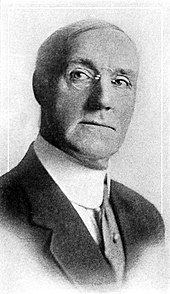A Christmas Carol (1908)
| Movie | |
|---|---|
| Original title | A Christmas Carol |
| Country of production | United States |
| Publishing year | 1908 |
| length | 15 minutes |
| Rod | |
| production | Essanay Film Mfg. |
| occupation | |
| |
A Christmas Carol is an American silent film from 1908 . It is considered the first American film adaptation of the Christmas story by Charles Dickens . The 15-minute black and white film was released on December 9, 1908, and the British theater actor Tom Ricketts played the main role of the curmudgeon Scrooge . The film was shot in the studios of Essanay Film Mfg. Co. in Chicago , nothing is known about the other roles or the film staff . Likewise, there is no showable copy of the film, it is therefore considered lost .
action
The plot description is based on a contemporary article from the film magazine The Moving Picture World . The first scene shows the curmudgeon Scrooge walking through the streets of London on Christmas Eve morning . He is approached by a beggar whom Scrooge furiously pushes to the ground. A ghost then appears and tells Scrooge that the beggar will visit him again. Scrooge reaches his office where the beggar is waiting for him again. He covers his face with his hands and when he takes them down the beggar has disappeared. His nephew Fred and his employee are waiting for him in his office. Fred informs Scrooge that he wants to get married. Scrooge finally approved the request for Christmas leave. The ghost then leads him to a happy crowd, but they ignore him. Finally Scrooge returns home, where the beggar is warming himself by the fireplace. Angry about this, Scrooge wants to pounce on the beggar, who, however, turns into an image of Scrooge's deceased business partner. Startled, he falls into the armchair in front of the fireplace and the ghost shows him scenes from his childhood and his first great love. Scrooge sinks to the ground in panic, but the ghost asks him again to follow him. The first thing he does is to get to his employees' house, where, at the command of the Spirit, he rains money over the family. His next stop is his nephew Fred's house, where he watches through the window as Fred makes a toast to him, but none of the people present want to raise their glasses to it. Here, too, he lets money rain over those present and vows to want to lead a different life in the future. Back home, Scrooge falls on his knees and says a prayer. The next day he gives a gala dinner for his family, employees and friends.
Reviews
In a contemporary review of The Moving Picture World magazine , the reviewer emphasizes the proximity to the original material. The film cannot be praised highly enough, the acting and the technical implementation are top notch. Especially the scene with a little girl, who is the only one to meet the protagonist with love, is touching and has caused one or two tears in the audience. After all, the film is a welcome change from the bloody films that were previously shown not only in New York . Fred Guida noted in his book A Christmas Carol and Its Adaptions , published in 2000 , that the plot had some interesting twists and additions to the original material.
Web links
- A Christmas Carol at the Internet Movie Database (English)
- A Christmas Carol on the website of the American Film Institute (English)
